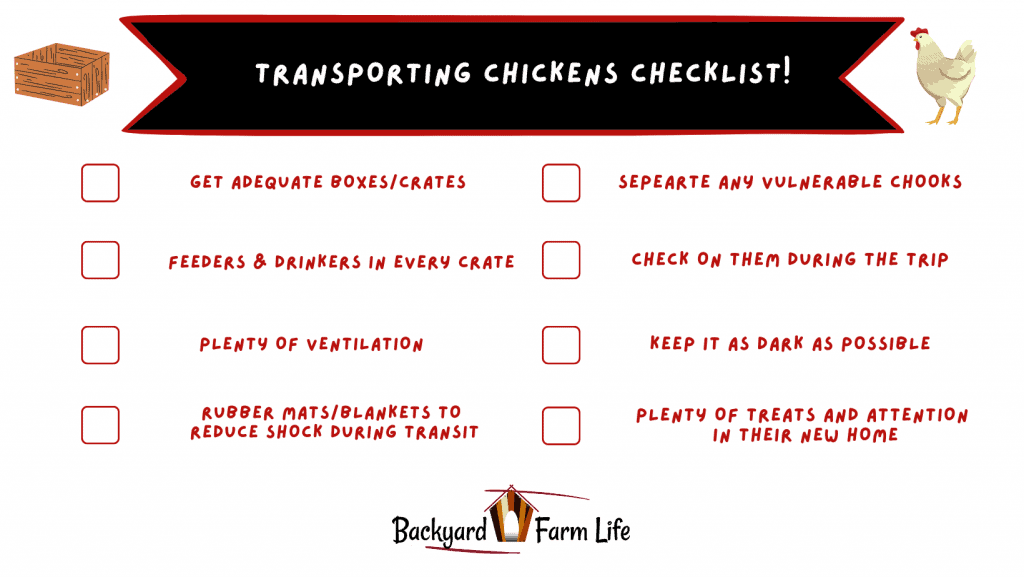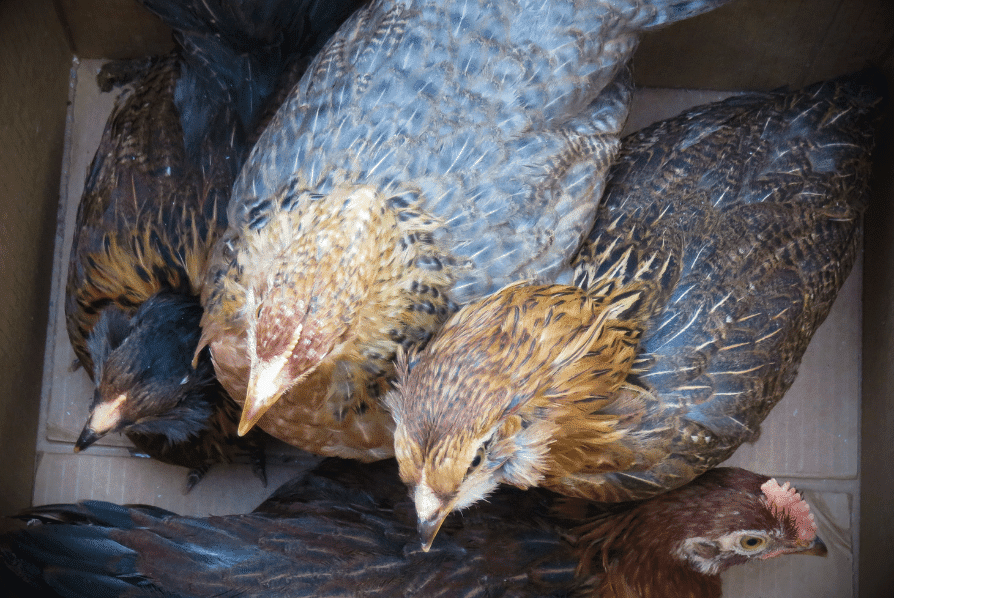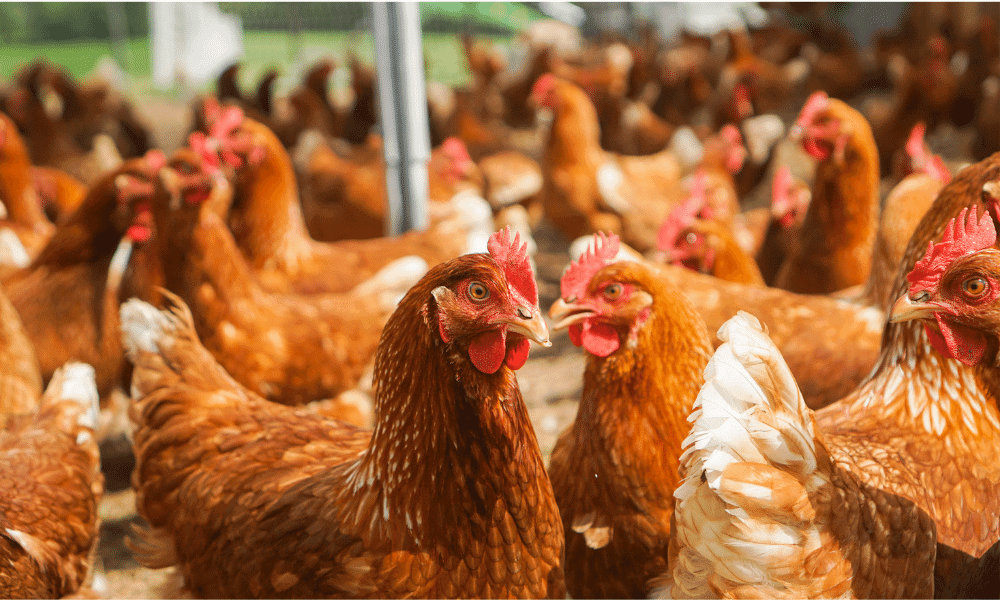Transporting chickens can be just as stressful for you as well as for your chooks. From all of the efforts in the preparation stage, to the drive, to setting up at the end. Plus, the lights, noise, and unfamiliar environment can easily overwhelm your chickens.
So, It’s important to take the necessary steps to make the journey as easy as you can for you – and your chicken’s sake!
Depending on the size of your flock there are a few different ways you could transport your chickens. Here is how to transport any amount of chickens, from 5, 10, 20, 50, up to 100+, highlighting the most important actions at every stage.
Contents
How To Transport Chickens

Depending on how many chickens you are transporting, things can vary from being rather simple to a seemingly overwhelming task.
Using small crates or boxes to hold two to three chickens each is normally the best way to go. By not overcrowding the box, your chickens will feel a lot calmer and it helps keep down the chaos.
Of course, for larger flocks, this isn’t always practical. In these cases, you can opt for larger transport boxes but still keep the number of chickens per crate down to make the ride a lot smoother.
But, no matter how many chickens you are transporting you should follow the same principles to be sure everything goes smoothly. From the preparation to the transport to helping your chickens settle in at the new location. Here is everything you need to know about transporting chickens.
Find A Suitable Carrying Container
First, find your choice of carrying containers depending on the size of the flock you’re transporting and the space you have available.
Flocks of around five chickens or less may just need a few slightly modified cardboard boxes, or small poultry crates. But, with flocks of above twenty, you’ll certainly want to have a few fully equipped poultry transport crates to relieve the stress of worrying about so many smaller boxes.
Always be sure your container allows enough airflow and ventilation for your chickens. This allows your chicken sufficient oxygen but also helps to keep the air fresh.
Although you do want airflow, you don’t want to let in unnecessary light. Transportation for chickens is highly stressful and providing them with dark boxes will induce a calm state. If you’re using poultry crates, you can cover them loosely with a towel or light blanket to block out excess light.
Lastly, be sure your crate or box is entirely secure and robust. You don’t want any chickens breaking loose or the box coming un-done during travel.
What To Include In Each Carrying Container
Just like we enjoy having refreshments and snacks on road trips or while traveling on flights, chickens have much of the same desires.
Depending on the length of your journey you may wish to provide more or fewer luxuries. But, no matter the length of the journey you should always make sure each of your chicken crates has food and water.
Prepare each of your transport boxes with:
- A portable feeder and portable drinker (secured against the side of the crate, so it doesn’t spill during transport).
- An appropriate amount of food and water for the travel.
- Wood shavings, pine needles, or other beddings to keep everything clean and fresh.
- Fragrant and soothing herbs for your chickens (thyme, lavender, etc.).
- Healthy treats like watermelon or mango.
- Thin sheets, blankets, or towels to drape over the crates.
Traveling Day
When it comes to transporting your chickens on the day, keep all necessary noise, movement, lights, and bumps to an absolute minimum. The key is to take every action possible to reduce the stress on them.
This means:
- Plan out your route avoiding any gravel roads or too many unnecessary turns where possible.
- Strategically add each of your chickens to your crates, including each chicken’s friends in the flock.
- Lay shock-absorbing rubber mats and noise-canceling linens on the bottom layer before placing your crates on top.
- Secure the crates down with rope or fixings so they don’t slide or move about.
- Regularly check on your chickens during transport, just to ensure nothing has drastically moved and is still traveling well.
- Droop light linens, towels, or sheets over the crates to further block lights and noise.
- Drive more slowly where possible.
Helping Them Settle In At the New Location
It’s never easy for animals to get accustomed to their new home, as there are so many unknown conditions in the unfamiliar environment.
It may take some time for your chickens to get back to their normal, personable selves, but there are a few things you can do to ensure they feel comfortable and well taken care of.
The first is to set up their new coop with the appropriate ventilation, insulation, nesting boxes, and protection from predators. The coop is essentially their safe haven, and it may even help if you can use the same or similar coop so they are instantly familiar with their surroundings
If you do have to build a new coop, try at least make it the same color as the previous one, as chickens associate colors with certain emotions, and will feel more comfortable.
When it comes to feeding newly transported chickens, it will always help if you provide them with electrolyte-enhanced water for a few days, just to help combat any potential stress-induced problems. Allow your chickens a few extra treats over this period too to keep them happy.
You can expect some egg production issues too, whether it’s simply less production, or if there are a few that come out not so perfectly! It’s also much more likely your chickens will run away if they aren’t used to their new home, so be aware of this when letting them free-range.
How To Transport 2-3 Chickens

If you’re only transporting two or three chickens, you only really need to use a sturdy, medium-sized cardboard box, or one small poultry crate.
If you want to go the box route, then simply find a decently sized and robust cardboard box and poke two holes in each side of the box for ventilation, about big enough to poke one finger through.
Be sure to equip the box or poultry crate with a small feeder and portable drinker. Because there is only one box you can easily put it in the backseat of a car and have someone hold it gently and supervise the chickens during transport. Be sure to properly seal the top though — you don’t want any chickens jumping out during the ride!
How To Transport 5 Chickens
Most small poultry crates can carry three to four birds at a time. So, to transport five chickens, you’ll need two crates or two separate boxes.
Although you can try to divide up your chickens based on their weight and size, always consider grouping the chickens that get along the best with each other to avoid any drama during the trip.
How To Transport 10 Chickens
When you’ve got a flock of 10 or so chickens, there are a few ways you can do it, and the best way will depend on how much room you’ve got allocated for them during transport.
In order to keep the stress to a minimum, it’s advised to transport your chickens in four separate boxes or crates, with 2-3 chickens per crate. Remember, the lower the number of chickens per box, the less stress there usually is during the move.
However, if you are needing more space, then you can simply use two larger, 30 x 22 x 4-inch crates. These large crates will comfortably fit eight adult chooks. So, putting 5 chickens in each will allow them plenty of space and comfort during transportation.
How To Transport 20 Chickens
With flocks of 20 or more, transporting starts to become cumbersome. It’s highly recommended to keep the number of chickens per crate as low as you can to for the well-being of your chooks.
So, instead of using two large crates that can fit 10 chickens each, try using four large crates with 5 chickens in each.
This will mean your chickens will be more easily able to move around, feed, and drink at their leisure.
How To Transport 50 Chickens

When it comes to larger flocks it does take a bit more pre-planning and preparation. It’s recommended to get yourself some commercial-grade poultry crates, as then you can transport them with confidence, not worrying about the integrity of the boxes during transit.
Remember not to overcrowd your chickens. It’s more important to transport them safely and comfortably than trying to fit them in fewer crates.
So, if you use a 30 x 22 x 4-inch crate that can hold 8 chickens comfortably, then you’ll only need 7-8 crates. Remember to separate any vulnerable chickens, and keep your chickens in the same pecking order to avoid any issues during transport.
Lay the crates horizontally first before you resort to stacking vertically. This makes checking up on them during the drive a bit easier.
How To Transport 100 Chickens
When you’re looking to transport 100 chickens or more, it’s essential you get the right vehicle in place to make it as smooth as possible, and so you can have the confidence nothing will go wrong during transit.
You might want to hire a utility trailer, an enclosed 5 x 8-foot trailer will generally be a good size for 100 chickens in their respective crates.
You’ll need around 15 crates for your chickens, and they’ll need to be carefully stacked, being careful that the lower level stacks aren’t smothered by anything else so they too can get adequate airflow and ventilation.
It’s recommended to get up early and load them all into their crates before sunrise, as chickens will be much more docile at this time. This will also mean you’ll be able to make all the preparations out of the glaring sun.
Before loading your chickens in their crates, be sure they are all equipped with adequate feeders and drinkers.
Once you’ve got all the crates carefully stacked and secured, do a check of each chicken crate to ensure it’s fully secure and the food and water are easily accessible before taking off.
Depending on the length of your trip, you may want to stop a few times to check in on your chooks to make sure they are all coping.
Tips To Reduce Stress When Transporting Chickens
Getting the crates, preparing their feeders and drinkers, putting your chickens in their crates, and renting a pickup truck is only half the task. The other half of your effort should go towards planning and preparing, ensuring that you’ve taken all the necessary steps to reduce the stress on your chickens while in this vulnerable state.
Here are a few tips that can make your trip easier:
- Check if the birds are healthy enough for transport. If you do have any vulnerable chickens, it’s important to separate these from your flock and let them ride in a less hectic environment where possible.
- Pick crates that are sturdy but have enough ventilation.
- Use a cloth cover-up to keep the temperature around 75℉.
- Add portable drinkers and feeders to each crate
- Use comfortable bedding
- Carry some tape and empty cardboard boxes, just in case you need to separate any chickens in an emergency.
Wrapping Up
Transporting poultry can be intimidating, especially if it’s your first time. The key here is to plan ahead and make every effort to reduce the stress on your chickens for their health and wellbeing.
Pick crates of a suitable size and be sure to do a mock-up load to see if the crates fit in your vehicle. Ventilation is key, but not so much that they are exposed to cold weather, wind, or any other unwanted elements. So long as your birds are comfortable, have access to food and water, and are in a safe dark place during transport you’ll be confident everything will go as well as it can.
Remember to drive safely and to check on your birds regularly if it’s a long trip!
